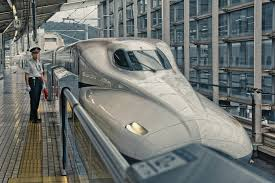Riding the bullet train (or shinkansen) in Japan is an iconic experience that combines cutting-edge technology, comfort, and efficiency. The shinkansen network is famous for its speed, punctuality, and smooth ride, making it a popular choice for both tourists and locals traveling between cities. Here’s what you need to know to make the most of your bullet train experience:
Overview of the Shinkansen
Speed and Efficiency:
- Speed: Shinkansen trains can travel at speeds up to 320 km/h (200 mph) on certain lines, significantly reducing travel time between cities.
- Punctuality: The trains are renowned for their punctuality, with delays being extremely rare.
Types of Shinkansen:
- Nozomi: The fastest service with the fewest stops. It’s available on the Tōkaidō Shinkansen line between Tokyo and Osaka.
- Hikari: A slightly slower service than Nozomi, but with more stops. It also operates on the Tōkaidō line.
- Kodama: The slowest service, stopping at all stations on its route.
- Other Lines: There are also several other lines, such as the Sanyō, Kyūshū, and Tōhoku lines, each with its own categories of services.
Planning Your Trip
Tickets:
- Purchase: Shinkansen tickets can be purchased at JR (Japan Rail) stations, online, or through travel agencies. Tickets are available for reserved seats, non-reserved seats, and Green Car (first-class) seats.
- Japan Rail Pass: If you plan to travel extensively on JR lines, consider the Japan Rail Pass. It offers unlimited travel on JR trains, including some shinkansen, for a fixed period. Note that the Japan Rail Pass does not cover Nozomi trains but does cover Hikari and Kodama services.
Booking:
- Reserved Seats: Booking in advance ensures you have a reserved seat, especially during peak travel seasons or for popular routes.
- Non-Reserved Seats: For less busy times, you can use non-reserved cars, which don’t require a seat reservation but are available on a first-come, first-served basis.
At the Station
Finding Your Platform:
- Signage: Stations are well-signposted in English and Japanese, making it easy to find your platform. Look for the shinkansen signs.
- Platform Tickets: Before boarding, you may need to pass through a gate to access the shinkansen platforms. Keep your ticket handy for inspection.
Luggage:
- Storage: Shinkansen cars have overhead racks for small luggage. For larger items, there are dedicated luggage areas at the end of each car or options for paid luggage forwarding services.
- Handling: If traveling with large luggage, consider using a luggage delivery service to send it to your destination in advance.
Onboard Experience
Comfort:
- Seating: Seats are spacious and comfortable, with ample legroom. You can recline your seat and use adjustable footrests.
- Amenities: Many shinkansen offer amenities such as reading lights, power outlets, and clean restrooms.
Food and Drink:
- Food Service: You can purchase food and beverages from trolley services that come through the cars, offering a selection of snacks, meals, and drinks.
- Ekiben: Station bento boxes (ekiben) are a popular choice for enjoying a meal on the train. These can be bought from station kiosks before boarding.
Scenery:
- Views: Enjoy the scenic views from your window, including picturesque countryside, Mount Fuji (on the Tōkaidō line), and coastal areas. The ride is smooth and quiet, providing a pleasant viewing experience.
Etiquette:
- Quiet Environment: Maintain a quiet and respectful environment. Keep phone conversations to a minimum and use headphones for any audio.
- Seat Placement: If you have reserved seats, check your ticket for the car number and seat number. Non-reserved seats are available on a first-come, first-served basis.
Popular Routes
Tokyo to Osaka:
- Duration: Approximately 2.5 to 3 hours on the Nozomi.
- Highlights: The Tōkaidō Shinkansen line is the most traveled route, connecting Japan’s major cities.
Tokyo to Kyoto:
- Duration: About 2 hours and 20 minutes on the Nozomi.
- Highlights: Offers a convenient way to reach Kyoto’s historic temples and traditional culture.
Tokyo to Hiroshima:
- Duration: Around 4 hours on the Nozomi.
- Highlights: Provides access to the historic Hiroshima Peace Memorial and nearby Miyajima Island.
Additional Tips
- Language: While many signs are in English, learning a few basic Japanese phrases can be helpful.
- Timing: Arrive at the station a little earlier to navigate the area and find your platform without rushing.
- Connection: If transferring between shinkansen lines or other trains, check connections in advance to ensure smooth travel.
Riding the shinkansen is not just about getting from one place to another; it's a memorable experience that showcases Japan’s technological advancements and hospitality. Enjoy your journey on one of the world’s fastest and most efficient train systems!


No comments:
Post a Comment